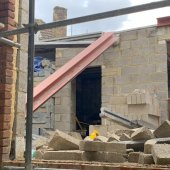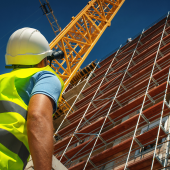Global green building report outlines measures to decarbonise built environment

An international alliance of five green building organisations has published a new report that outlines how sustainable finance can be unlocked to enable the rapid and wide-scale transition of low-performing building stock to a decarbonised future.
Published at the end of 2024, Building Transition: Financing Market Transformation focuses on three critical areas that the international partners argue will help the broader built environment to implement green building practices that also strengthen resilience and support vulnerable communities.
The global alliance brings together organisations in Australia, France, Singapore, the United States and the UK that oversee internationally recognised building certification systems. The Building Research Establishment is the UK’s representative.
As the joint letter issued by the five CEOs in the report explains, the new document builds on the alliance’s first guide, Financing Transformation: A Guide to Green Building for Green Bonds and Green Loans, published last summer.
This guide outlines how integrating the five members’ building certification systems – BREEAM, HQE, LEED, Green Mark and Green Star – can provide a framework for unlocking capital for green projects.
Although the global alliance acknowledges that most low-performing buildings will struggle to achieve green building certification, it recognises that third-party green building certifications do provide a framework for achieving environmental, social and governance (ESG) and climate goals. BRE also notes that schemes like BREEAM In-Use do allow low-performing buildings to achieve this certification for operational, standing assets.
In its latest “joint call for action”, the alliance argues that relevant stakeholders – financial institutions, policy makers and building owners – must co-ordinate their actions and access sustainable finance if they are to benefit from the green building technologies and strategies that will improve the performance and resilience of the wider building stock.
The report notes how a failure to manage the related risks could prove more costly, for example, through higher insurance premiums
Building Transition: Financing Market Transformation identifies three critical focus areas: the need for better taxonomies; defining a credible decarbonisation transition; and adapting to climate change. Its report outlines detailed recommendations for action for financial organisations, policy makers and building owners.
The alliance explains that the three priorities identified are essential for setting the conditions for an inclusive and rapid transition.
Regarding the first priority identified, the report explains how the sustainable finance sector is currently hindered by divergent taxonomies, sometimes vague criteria and misalignment with established building practices such as green building certification (rating tools).
As the alliance notes, this can cause confusion and increased costs for stakeholders. What’s more, this fragmentation restricts investment in new and existing buildings which can often lead to an undervaluation of assets that could achieve meaningful sustainability improvements.
"To address these challenges, taxonomies should embrace context-specific, performance-oriented criteria while harmonising approaches with a focus not just on 'green' but on how to scale the transition of the sector as a whole," argued the alliance.
"Engaging with industry experts and collaborating with organisations such as the national Green Building Councils, the World Green Building Council regional networks, and Global Real Estate Sustainability Benchmark (GRESB) Foundation is crucial for developing comprehensive guidelines and implementing effective strategies that properly address the complex and multifaceted nature of the built environment."
The alliance added that, by fostering a cohesive, transparent and adaptable approach, ‘sustainable finance taxonomies can effectively mobilise capital towards truly sustainable projects, driving continuous improvement and advancing global environmental goals.’
In defining a credible decarbonisation transition, the report advocates a ‘common but differentiated approach’ that reflects the requirements of each individual building and provides a pathway for improvement.
It also highlighted how green building certification schemes can provide science-backed best practices, widespread guidance to build carbon literacy and incentives to accelerate and verify their implementation. In addition, the report outlines a range of recommendations for different stakeholders (see box).
On the importance of adapting to a changing climate, the report pointed to the increasing severity and frequency of events and the growing financial costs incurred.
With lenders, insurers and regulators increasingly recognising the importance of property resilience, the report notes how a failure to manage the related risks could prove more costly, for example, through higher insurance premiums. At the same time, it states how improving resilience can provide a competitive edge, for example, through reduced damages and downtime, lower insurance costs and long-term savings in maintenance and repair. The report noted how green building practices can increase resilience.
"Energy efficiency and on-site renewable energy reduce vulnerability
to power grid disruptions," noted the report, adding that "design features such as passive cooling, natural ventilation and advanced insulation reduce vulnerability to extreme temperatures".
Bridging the gap between high-performing and underperforming buildings is essential to achieving our global decarbonisation goals
In addition, the report points to how water-efficient systems reduce vulnerability during droughts or water supply disruptions.
"Sustainable materials are often more durable and require less maintenance, which enhances resilience by extending their lifespan and reducing resource consumption," added the report.
"This durability minimises waste and lowers greenhouse gas emissions and ensures that structures can better withstand climate-related challenges, ultimately leading to cost savings and improved long-term sustainability. At a societal level, the lower emissions and resource consumption of green buildings help mitigate the environmental factors contributing to climate-related disasters."
The report noted how several green rating systems, including BREEAM, Green Mark, Green Star, HQE and LEED all have requirements related to risk assessment and mitigation associated with natural hazards. It outlined recommendations for financial institutions, policy makers and building owners (see box, below).
"Bridging the gap between high-performing and underperforming buildings is essential to achieving our global decarbonisation goals," Jane Goddard, Deputy CEO at BRE, told Building Engineer.
"This report underlines the importance of inclusive investment strategies that unlock capital for the majority of buildings, ensuring that no part of the built environment is left behind.
"At BRE, we believe that scalable, context-specific solutions – backed by robust data, strong policies, and global standards – are key to transforming the built environment and meeting the urgent challenges of climate change."
Recommendations for credible decarbonisation transition
Financial organisations:
- Look for the fundamental elements of decarbonised buildings outlined in the report when assessing the climate risks and opportunities of assets. These offer a more comprehensive picture of an asset transition pathway than any one or two data points at a fixed moment in time.
- In addition to green financing products, focus on transition financing that supports the wider holistic transition of the built environment, including developing products that offer as-a-service models for building retrofits, allowing zero capital cost models with shared savings, and allowing inclusive opportunities for a wider demographic of buildings to retrofit.
- Incorporate independently verified building rating tools into investment and lending decisions to better manage climate-related risks and to better identify and capitalise on appropriate green investment opportunities. Include lower levels of rating to capture transition opportunities and improvements over time.
- Collaborate with industry stakeholders to better understand existing recognised building rating schemes to standardise metrics and reporting for sustainability performance.
Building owners:
- Prioritise electrification, energy efficiency, and responsible products in both new developments and existing properties to enhance value and reduce operational costs.
- Create decarbonisation plans that chart a course to zero or low carbon over time that consider technical, financial and building lifecycle milestones considerations.
- Pursue green building certifications to demonstrate commitment to sustainability and hold design and operation teams accountable for results.
- Stay informed about regulatory changes and emerging technologies to remain competitive in a rapidly evolving market.
Policy makers:
- Implement and enforce regulations that promote the removal of fossil fuels, improved energy efficiency and sustainability in the built environment, including a mix of incentives for green building practices and timebound requirements that would impact the ability to sell or rent poor-performing assets, which would drive the scale of action needed.
- Offer default risk share schemes for financial institutions to extend debt mechanisms to a wider pool of asset owners for retrofits to encourage an inclusive transition.
- Support research and development in green technologies and materials to reduce costs and improve accessibility.
- Facilitate collaboration between public and private sectors to drive large-scale decarbonisation initiatives.
Source: Building Transition: Financing Market Transformation
Recommendations for adapting to climate change
Financial organisations:
- Integrate climate risk into underwriting and asset valuation: Quantify the potential value at risk from chronic and acute climate events and incorporate these risks into property underwriting and building valuations. This will ensure that asset values accurately reflect their exposure and resilience, guiding more informed investment decisions.
- Support clients in navigating their climate transition: Proactively engage clients on their climate risks and transition plans, offering resilience solutions coupled with tailored financing options to mitigate these risks. This helps align financial products with long-term sustainability goals and reduces exposure to climate-related disruptions.
- Plan for what to do for people who own stranded assets: We all share the responsibility for assets that will genuinely be impacted by extreme weather events regularly. Flooding, hurricanes, bushfires, etc., are levelling events – but the people living there are genuinely impacted by decisions made decades ago to build there. The finance sector benefitted from these decisions and should develop programmes to assist these stakeholders.
Building owners:
- Assess the financial risk from chronic and acute events and quantify the potential value at risk.
- Identify and implement measures to increase resilience, which may require looking beyond the individual asset to the precinct or neighbourhood where the asset(s) resides and the stakeholders who rely upon the services a building provides.
- Communicate resilience features to potential tenants and the broader market; increase occupant awareness and demand for resilience.
Policy makers:
- Develop policies and standards to encourage private sector investment and leverage public sector funding: This aligns directly with the need to establish clear frameworks for sustainable finance and investment, ensuring that both public and private sectors can collaborate effectively. Reference to ISO 14090:2019 and frameworks like the World Bank’s Building Regulation for Resilience provide concrete pathways for implementation.
- Help facilitate industry consensus on assessing, quantifying, and monetising resilience: Establishing consistent methodologies for measuring and valuing resilience is crucial for driving investment in sustainable finance. Clear, standardised metrics will help investors understand the financial benefits of resilience, making it easier to attract capital to resilient projects.
- Ensure regulatory frameworks drive finance to risk mitigation measures in new construction and major renovations: Offering financial incentives to incorporate resilience measures directly supports the transition by making these investments more attractive and feasible for developers and property owners, encouraging broader market adoption.
- Update data collection requirements for property condition and seismic risk assessments to require data on climate risk.
- Liaise and advocate with municipal authorities to increase infrastructure resilience concomitantly with asset-level resilience investments.





